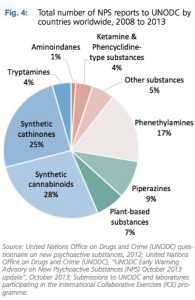The New Frontier of Synthetic Drugs

In 1988, Gary Henderson, a professor of pharmacology at the University of California-Davis Medical School, predicted the coming global problem with synthetic drugs. He wrote that the scientific literature was full of potential synthetic routes and pharmacological properties for a wide variety of drugs. He said that information was readily available for “clandestine chemists” to exploit. Restricting access was not feasible and controlling the chemicals needed to make these drugs would only have a minimal effect. Henderson prophetically said:
It is likely that the future drugs of abuse will be synthetics rather than plant products. They will be synthesized from readily available chemicals, may be derivatives of pharmaceuticals, will be very potent, and often very selective in their action. In addition, they will be marketed very cleverly.
Today, news about the problems with synthetic drugs or new psychoactive substances (NPS) is hard to avoid. The parents on a 19-year-old who died after smoking synthetic marijuana started a facebook page in his memory. The governor of New Hampshire declared a state of emergency because of the overdose deaths from “Smacked,” a synthetic marijuana sold in convenience stores.
A Minnesota teen pled guilty to third-degree murder when the N-Bomb, a synthetic form of LSD, he supplied to several other teens resulted in an overdose death. The DEA reported that N-Bomb was responsible for at least 19 deaths between March of 2012 and November of 2013. A survey of 15,000 high school students in Minnesota revealed that 12% had used synthetic drugs. Minnesota has responded by launching a synthetic drug awareness website, KnowTheDangers.com. Drug WarFacts.org has a page devoted to information on NPS.
The problem is truly a worldwide one. By 2013, NPS had been identified in every region of the world. The majority of NPS worldwide were in three basic groups: synthetic cathinones, synthetic cannabinoids and phenethylamines. Together they accounted for 70% of the total number of reported NPS. See the following chart found in the 2014 Global Synthetic Drugs Assessment:
 Japan introduced new laws to combat its growing synthetic drug problems. “Speckled Cross” resulted in 20 deaths in Northern Ireland. Synthetic cannabis is a growing problem in UK prisons. One prison reported that 85% of its inmates were using or supplying Spice. The chief inspector of prisons in the UK said: “What we can say for definitive is that spice is a significant problem in a number of prisons and it is rising.” DrugScope put together a status report on NPS and ‘club drugs’ in the UK.
Japan introduced new laws to combat its growing synthetic drug problems. “Speckled Cross” resulted in 20 deaths in Northern Ireland. Synthetic cannabis is a growing problem in UK prisons. One prison reported that 85% of its inmates were using or supplying Spice. The chief inspector of prisons in the UK said: “What we can say for definitive is that spice is a significant problem in a number of prisons and it is rising.” DrugScope put together a status report on NPS and ‘club drugs’ in the UK.
A DEA spokesperson, Rusty Payne, called synthetic drugs the new frontier: “As chemistry and science advances, we’re seeing more and more drugs, designer drugs, new derivatives, new compounds that are making their way into the Unites States and across the world.”
“Effects and Risks Associated with Novel Psychoactive Substances” gathered together helpful information on the pharmacology, clinical effects and adverse effects of the more common classes of NPS. See the original article for more details than the following summary.
Synthetic cathinones or “bath salts” can have both stimulant and hallucinogenic effects. They can cause severs intoxication. Their adverse effects include cardiovascular problems such as tachycardia—a faster than normal heart rate (22-56%), arterial hypertension (4-25%), palpitations (11-28%), dyspnea—shortness of breath (8-11%), and others. Psychiatric adverse effects include: agitation (50-82%), aggression (57%), hallucinations (27-40%), confusion (14-34%), anxiety (15-17%), and others. The psychotic adverse effects often consist of paranoia and hallucination (auditory and visual) that can persist for up to four weeks.
“Spice” or synthetic cannabinoids are much more potent, longer-acting and have worse adverse effects than THC. These adverse effects include: cardiovascular problems such as tachycardia (36-76%), arterial hypertension (10-34%), ECG changes (2-14%), chest pain (7-10%) and others. Neurological effects are present and can include: dizziness (9-24%), loss of consciousness (2-17%), somnolence—sleepiness (17-19%) and others. Psychiatric adverse effects include: agitation (19-41%), hallucinations (11-38%), anxiety/panic attacks (21%), and others.
Effects and Risks” also had some information on a phenylethylamine first synthesized in 1998, “Bromo-dragonfly.” It has a LSD-like effect that could last up to six hours. The effect includes visual and auditory hallucinations and a feeling of well-being that could last up to three days. It is highly toxic and has been associated with a number of deaths from overdose (study abstract here). A pro-drug website, Erowid, has a page of information (positive and negative) on Bromo-Dragonfly that included difficult experiences, bad trips and health problems. One report was titled: “Thankful That I’m Alive.” Probably the most disturbing piece I saw was a YouTube video, “My Bromo-DragonFLY Trip” by a young woman who sounded like she was describing an exciting, unexpected encounter while on a road trip with friends.
The 2014 Global Synthetic Drugs Assessment said it was still not clear if NPS were replacing other controlled substances. Maybe they are simply supplements to the existing bevy of drugs under international control. Then again, maybe we ain’t seen nothing yet.
